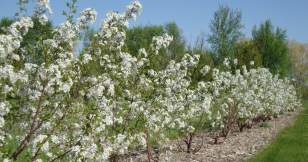Canadian Dwarf Sour Cherries – Prunus x kerrasis
Canadian Dwarf Sour Cherries Update 2014-2017
Canadian Dwarf Sour Cherries Update 2013
Canadian Dwarf Sour Cherries Update 2011-12
Canadian Dwarf Sour Cherries Update 2007-10
Dwarf sour cherries are being planted extensively in the Canadian Prairie Provinces. Their advantage is that they are adapted to the use of the machine harvesters used by Saskatoon growers. In the Prairie Provinces, these sour cherries are hardy (Zone 2), pest free, non-suckering, compact shrubs with completely red-fleshed fruit that has a sugar content almost twice that of Michigan cherries.
Sour cherry production in the Canadian Prairies is a relatively recent development. The University of Saskatchewan’s ‘Romance Series’ cherries were officially released in 2004. The number of operations reporting the crop climbed from 47 operations in 1996 to 155 in 2006, and to 193 in 2011, the latest reporting year. The area devoted to sour cherries in the three Prairie Provinces climbed from 37 to 324 acres. (Statistics Canada, Census of Agriculture.)
History: In the late 40's, Dr. Les Kerr began intercrossing Prunus cerasus and P. fruiticosa at Agriculture and Agri-Food Canada’s Morden Research Center. Later, as director of the PFRA Tree Nursery (now Forestry Farm Park), in Saskatoon, he released and promoted a cold-hardy bush sour cherry that was never named. These short shrubs with quite sour fruit may still be sold as Mongolian cherries today.
In the 1970s, the University of Saskatchewan imported and began evaluating hybrids of P. cerasus and P. fruiticosa from Siberia under the direction of Dr. Stewart Nelson and technician, Rick Sawatzky. Dr. Kerr donated his cherry germplasm to the university in the 1980s and breeding work continued with goals to combine cold hardiness, dwarf stature and fruit quality.
In 1985, Dr. Cecil Stushnoff and Rick Sawatsky began making crosses with the high quality, cold tolerant cultivar (Zone 4a) ‘North Star’ from Minnesota. In the late 1990s the university distributed thousands of improved seedlings under the name of P. eminens to farmers and gardeners. (This name was used because P. fruiticosa x P. cerasus hybrids resemble P. eminens, which is believed to be a naturally occurring hybrid of these two species.) The cooperating growers helped to identify superior seedlings which were used in future breeding.
These crosses with ‘North Star’ resulted in the release of the variety ‘SK Carmine Jewel’ in 1999. In 2004, five more cherry varieties were released under the title: Romance Series. They include: ‘Juliet’, ‘Valentine’, ‘Cupid’, ‘Romeo’ and ‘Crimson Passion’. All of these cherries are bigger, redder and sweeter than Michigan pie cherries. These hybrids are 75% P. cerasus and 25% P. fruiticosa and will probably be named P. x kerrasis to honor the work of Dr. Kerr. The fruit easily approaches a Brix rating of 16 to 22%, but still contains the citric acid than makes them “tart” or “sour” cherries. Typical ‘Montmorency’ pie cherries fall into the range of 11 to 16 degrees Brix.
Growing Cherries: In the US, we can now buy 4 varieties from this series: ‘Carmine Jewel’, ‘Crimson Passion’, ‘Juliet’ and ‘Romeo’. ‘Carmine Jewel’ is the smallest and tartest fruit. ‘Crimson Passion’ is large and lower in acidity, but it has not borne fruit regularly at CREC. We are just planting the other two in 2015. Plants are self-fruitful and should produce a crop from just one shrub.
These plants would like to grow as shrubs and not trees. Because they sucker so little, the recommendation is to plant the one-year transplants 3-4 inches deeper than the current top of the root ball in order to bury extra buds that can serve as ‘back ups’ in case the upper plant is girdled or broken off.
The plants are hardy and grow quickly. Prune in a vase shape – or don’t prune at all. Fruit isn’t ripe until several weeks after color change. Be watchful for the insect pest Spotted Winged Drosophila (SWD) as cherries are a favorite fruit in which to lay eggs. If SWD is a concern, pruning is recommended to decrease shady resting places for the insect and to increase spray penetration.
--History information is derived from published material at www.fruit.usask.ca



